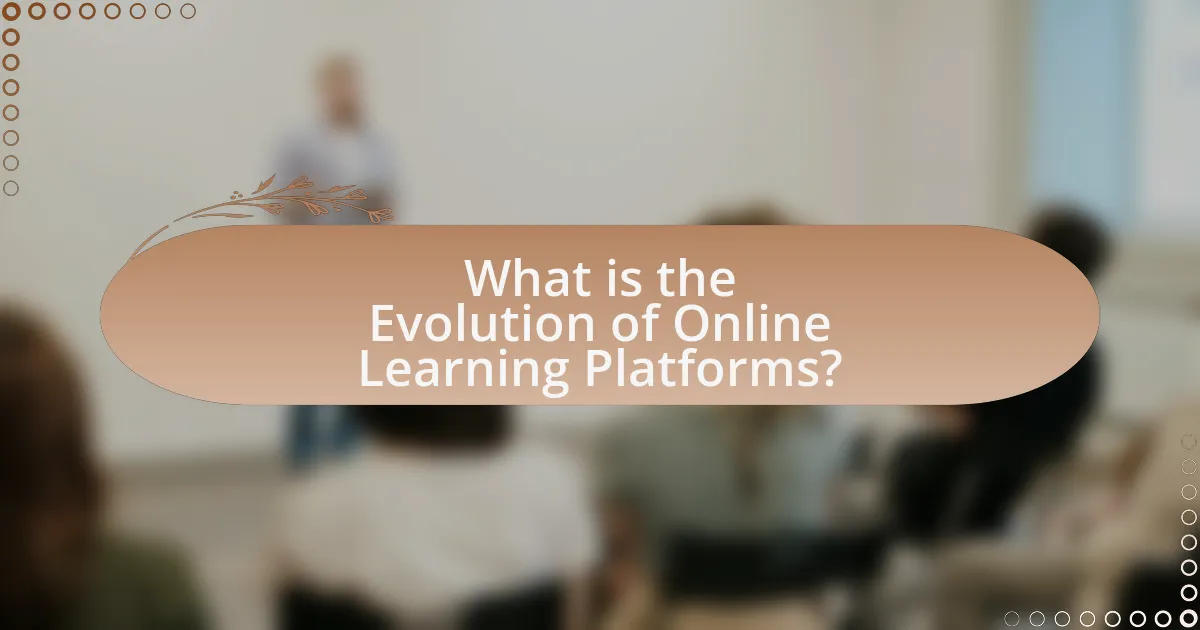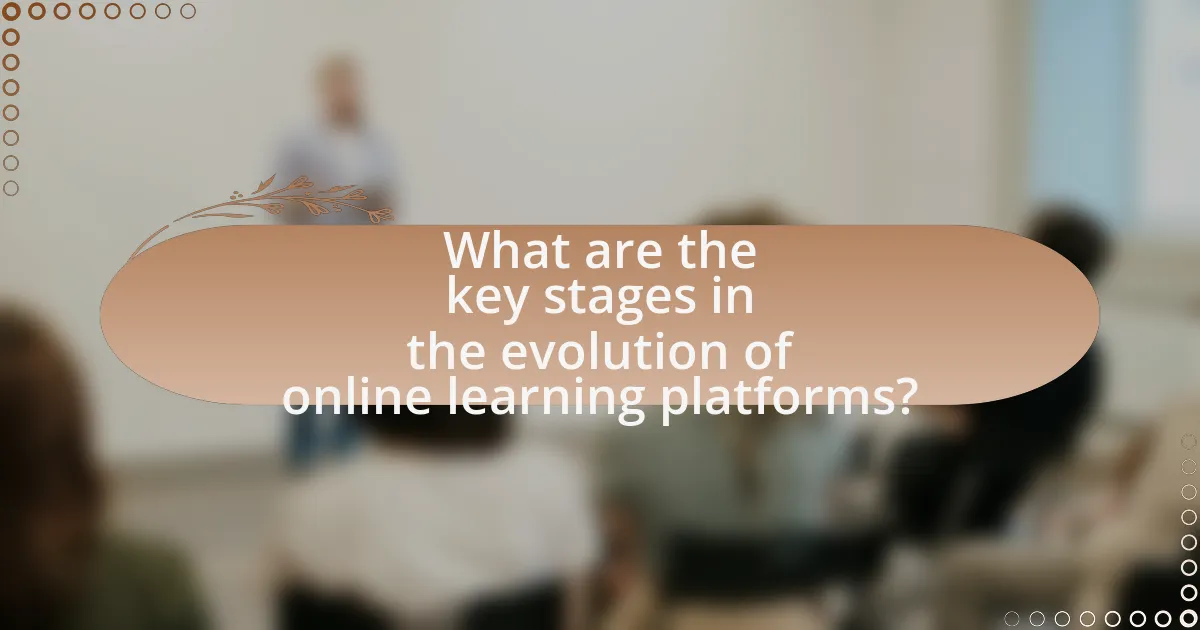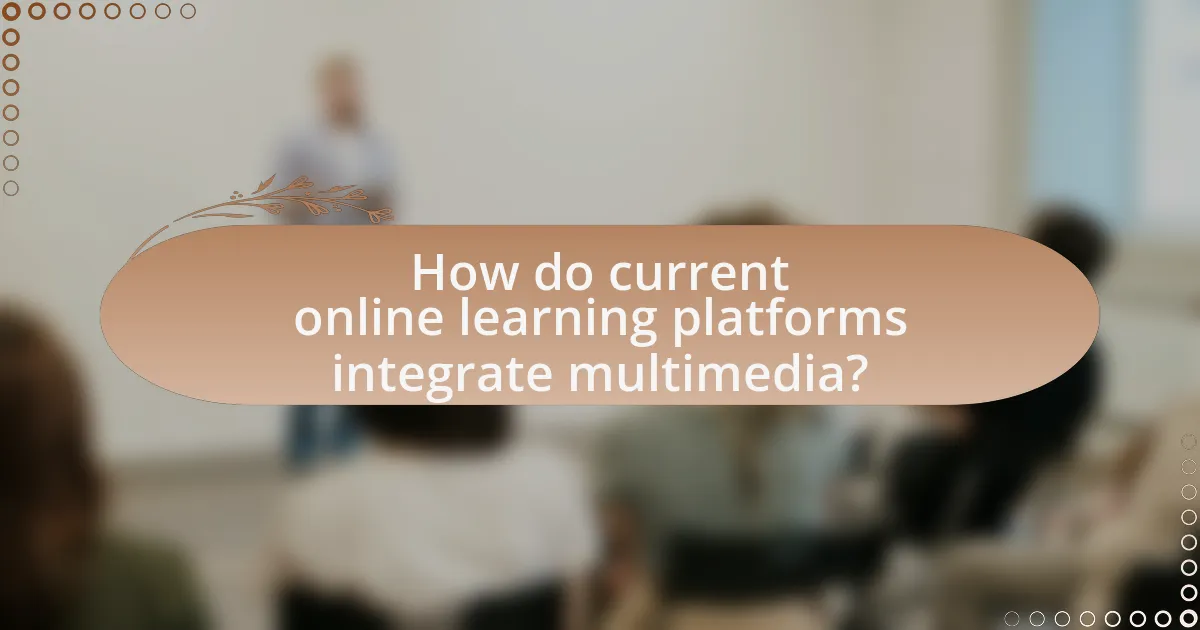The article examines the evolution of online learning platforms, tracing their development from text-based systems in the 1960s to the multimedia-rich environments of today. It highlights key milestones, including the introduction of Learning Management Systems in the 1990s, the rise of MOOCs in the 2010s, and the integration of interactive elements and gamification. The discussion emphasizes the significance of technological advancements, user engagement, and the impact of multimedia on educational accessibility and effectiveness. Additionally, it addresses the challenges faced in multimedia integration and offers best practices for enhancing learning outcomes through diverse content formats.

What is the Evolution of Online Learning Platforms?
The evolution of online learning platforms began in the 1960s with the introduction of computer-based training systems, which primarily utilized text-based content. In the 1990s, the advent of the internet led to the development of Learning Management Systems (LMS) that allowed for more interactive and accessible learning experiences. By the early 2000s, platforms like Moodle and Blackboard emerged, integrating multimedia elements such as videos and quizzes, enhancing user engagement. The rise of Massive Open Online Courses (MOOCs) in the 2010s, exemplified by platforms like Coursera and edX, further transformed online education by offering courses from prestigious universities to a global audience. This progression reflects a shift from static, text-heavy content to dynamic, multimedia-rich environments that cater to diverse learning styles and preferences.
How have online learning platforms changed over time?
Online learning platforms have evolved significantly from primarily text-based formats to rich multimedia experiences. Initially, these platforms offered basic content delivery through static text and simple quizzes, limiting engagement and interactivity. Over time, advancements in technology introduced features such as video lectures, interactive simulations, and gamified learning, enhancing user experience and retention. For instance, platforms like Coursera and Udemy now incorporate video content, discussion forums, and peer assessments, which have been shown to improve learning outcomes. According to a report by the Online Learning Consortium, the integration of multimedia elements has led to a 60% increase in student engagement compared to traditional text-based methods. This transformation reflects a broader trend towards personalized and adaptive learning environments that cater to diverse learning styles.
What were the earliest forms of online learning platforms?
The earliest forms of online learning platforms were primarily text-based systems, such as Computer-Assisted Instruction (CAI) and early Learning Management Systems (LMS) developed in the 1960s and 1970s. These platforms utilized basic computer technology to deliver educational content, often in the form of programmed instruction, quizzes, and assessments. For instance, the PLATO system, created at the University of Illinois in 1960, is recognized as one of the first CAI systems, offering a range of courses and interactive learning experiences. Additionally, the emergence of the Internet in the 1990s led to the development of more sophisticated LMS like Blackboard and WebCT, which expanded the capabilities of online education by integrating multimedia elements and facilitating communication between students and instructors.
What technological advancements influenced these changes?
Technological advancements that influenced the evolution of online learning platforms from text-based to multimedia include the development of high-speed internet, interactive multimedia software, and mobile technology. High-speed internet enabled seamless streaming of video and audio content, allowing for richer educational experiences. Interactive multimedia software, such as Adobe Captivate and Articulate Storyline, facilitated the creation of engaging learning modules that incorporate video, animations, and quizzes. Additionally, the proliferation of mobile technology, including smartphones and tablets, allowed learners to access educational content anytime and anywhere, further enhancing the flexibility and reach of online learning platforms. These advancements collectively transformed the landscape of online education, making it more dynamic and accessible.
Why is the evolution of online learning platforms significant?
The evolution of online learning platforms is significant because it has transformed education accessibility and delivery methods. This transformation allows learners from diverse backgrounds to access quality educational resources anytime and anywhere, breaking geographical and financial barriers. For instance, a report by the Online Learning Consortium indicates that enrollment in online courses has increased by over 150% since 2002, highlighting the growing reliance on digital education. Furthermore, the shift from text-based content to multimedia formats, such as videos and interactive simulations, enhances engagement and retention, as supported by research from the University of California, which found that students learn better when information is presented in multiple formats.
How has this evolution impacted educational accessibility?
The evolution of online learning platforms from text-based formats to multimedia has significantly enhanced educational accessibility. This transformation allows diverse learning styles to be accommodated, as multimedia resources such as videos, interactive simulations, and audio content engage learners more effectively than traditional text alone. According to a study by the U.S. Department of Education, students in online learning conditions performed better, on average, than those receiving face-to-face instruction, highlighting the effectiveness of multimedia in education. Furthermore, platforms like Coursera and Khan Academy have democratized access to quality education, enabling learners from various backgrounds and geographical locations to access resources that were previously limited to specific institutions.
What role does user engagement play in this evolution?
User engagement is crucial in the evolution of online learning platforms as it directly influences the effectiveness and adaptability of educational content. High levels of user engagement lead to increased retention rates, with studies indicating that engaged learners are 60% more likely to complete courses compared to disengaged ones. Furthermore, user feedback gathered through engagement metrics informs platform developers about content preferences and learning styles, enabling continuous improvement and personalization of the learning experience. This iterative process enhances the transition from text-based to multimedia formats, as platforms adapt to meet the evolving needs of users, ultimately fostering a more interactive and effective learning environment.

What are the key stages in the evolution of online learning platforms?
The key stages in the evolution of online learning platforms include the emergence of text-based courses, the introduction of multimedia content, the development of interactive learning environments, and the integration of artificial intelligence and personalized learning. Initially, online learning began with simple text-based courses in the 1990s, which provided basic information without interactivity. As technology advanced, platforms incorporated multimedia elements such as videos and audio, enhancing engagement and understanding. The next stage saw the rise of interactive features, including quizzes and discussion forums, fostering collaboration among learners. Finally, the latest evolution involves the use of artificial intelligence to create personalized learning experiences, adapting content to individual learner needs, which has been supported by research indicating improved learning outcomes through tailored educational approaches.
What characterized the text-based learning era?
The text-based learning era was characterized by the predominance of written content as the primary medium for educational delivery. During this period, learning materials such as textbooks, articles, and written assignments were the main resources utilized by learners, emphasizing reading comprehension and written communication skills. This era relied heavily on static text, with limited interactivity or multimedia elements, which shaped the learning experience primarily through reading and writing tasks. The effectiveness of this approach was supported by studies indicating that text-based learning can enhance critical thinking and analytical skills, as learners engaged deeply with the material through reading and reflection.
What limitations did text-based platforms face?
Text-based platforms faced significant limitations in user engagement and interactivity. These platforms primarily relied on written content, which often led to lower retention rates among learners compared to multimedia formats. Research indicates that learners retain only 10% of information presented in text, while retention increases to 65% when visuals are included (Mayer, 2001). Additionally, text-based platforms struggled with accessibility, as users with visual impairments or reading difficulties found it challenging to engage with solely text content. The lack of immediate feedback and interactive elements further hindered the learning experience, making it less effective in fostering comprehension and application of knowledge.
How did user feedback shape the transition from text-based to multimedia?
User feedback significantly influenced the transition from text-based to multimedia in online learning platforms by highlighting the limitations of text-only content. Users expressed a preference for more engaging and interactive learning experiences, which led developers to incorporate videos, animations, and interactive elements. Research conducted by the Online Learning Consortium in 2020 indicated that 70% of learners found multimedia resources more effective for understanding complex concepts compared to traditional text. This feedback prompted educational platforms to prioritize multimedia integration, enhancing user engagement and improving learning outcomes.
What innovations marked the shift to multimedia learning platforms?
The shift to multimedia learning platforms was marked by innovations such as the integration of video content, interactive simulations, and gamification. These advancements enhanced user engagement and facilitated diverse learning styles. For instance, the introduction of video lectures allowed for visual and auditory learning, which has been shown to improve retention rates. Additionally, interactive simulations provided hands-on experience in a virtual environment, making complex concepts more accessible. Gamification elements, such as rewards and challenges, further motivated learners by incorporating game-like features into educational content. These innovations collectively transformed the online learning experience, making it more dynamic and effective.
How did video and audio enhance the learning experience?
Video and audio significantly enhanced the learning experience by providing dynamic and engaging content that caters to various learning styles. These multimedia elements facilitate better retention of information, as studies show that learners retain 65% of information when it is presented visually and aurally, compared to only 10% when reading text alone. Additionally, video and audio can illustrate complex concepts through demonstrations and real-life examples, making abstract ideas more accessible. This multimodal approach not only increases engagement but also fosters a deeper understanding of the material, as evidenced by research conducted by the University of California, which found that students using multimedia resources scored higher on assessments than those relying solely on text-based materials.
What role do interactive elements play in multimedia platforms?
Interactive elements are crucial in multimedia platforms as they enhance user engagement and facilitate active learning. By allowing users to participate actively through quizzes, simulations, and clickable content, these elements promote deeper understanding and retention of information. Research indicates that interactive features can increase learner motivation and satisfaction, leading to improved educational outcomes. For instance, a study published in the Journal of Educational Psychology found that students who engaged with interactive content scored significantly higher on assessments compared to those who used traditional text-based materials. This demonstrates that interactive elements are not just supplementary but integral to the effectiveness of multimedia learning experiences.

How do current online learning platforms integrate multimedia?
Current online learning platforms integrate multimedia by incorporating various formats such as videos, audio recordings, interactive simulations, and infographics into their course materials. This integration enhances the learning experience by catering to different learning styles, making content more engaging and accessible. For instance, platforms like Coursera and Udemy utilize video lectures to provide visual explanations, while interactive quizzes and simulations allow learners to apply concepts in real-time. Research indicates that multimedia learning can improve retention rates by up to 60%, demonstrating its effectiveness in educational settings.
What types of multimedia are commonly used in online learning today?
Commonly used types of multimedia in online learning today include videos, interactive simulations, podcasts, infographics, and virtual reality. Videos serve as a primary medium for delivering lectures and demonstrations, enhancing engagement and understanding. Interactive simulations allow learners to practice skills in a controlled environment, promoting experiential learning. Podcasts provide audio content that learners can consume on-the-go, catering to auditory learners. Infographics present complex information visually, aiding in comprehension and retention. Virtual reality offers immersive experiences that can simulate real-world scenarios, making learning more impactful. These multimedia elements collectively enhance the learning experience by catering to diverse learning styles and improving information retention.
How do animations and simulations contribute to learning outcomes?
Animations and simulations enhance learning outcomes by providing interactive and engaging experiences that facilitate understanding of complex concepts. Research indicates that these multimedia tools improve retention rates and comprehension, as they allow learners to visualize processes and scenarios that are difficult to grasp through text alone. For instance, a study published in the Journal of Educational Psychology found that students who used simulations scored 20% higher on assessments compared to those who relied solely on traditional learning methods. This demonstrates that animations and simulations not only make learning more enjoyable but also significantly boost academic performance by catering to diverse learning styles.
What is the impact of gamification on learner engagement?
Gamification significantly enhances learner engagement by incorporating game-like elements into educational experiences. This approach increases motivation, as learners are more likely to participate actively when they encounter rewards, challenges, and competition. Research by Hamari, Koivisto, and Sarsa (2014) indicates that gamification can lead to a 30% increase in engagement levels among learners. Additionally, a study published in the Journal of Educational Psychology found that students exposed to gamified learning environments demonstrated improved retention rates and higher satisfaction levels compared to traditional methods. These findings underscore the positive impact of gamification on learner engagement in online learning platforms.
What challenges do online learning platforms face in multimedia integration?
Online learning platforms face several challenges in multimedia integration, primarily related to technical limitations, content accessibility, and user engagement. Technical limitations include issues with bandwidth and device compatibility, which can hinder the delivery of high-quality multimedia content. For instance, a study by the Online Learning Consortium found that 70% of students reported difficulties accessing video content due to slow internet connections. Content accessibility poses another challenge, as multimedia elements must be designed to accommodate diverse learning needs, including those of students with disabilities. Lastly, user engagement can be affected by the overwhelming amount of multimedia options, leading to cognitive overload, as highlighted in research published in the Journal of Educational Psychology, which indicates that excessive multimedia can detract from learning outcomes.
How do technical issues affect user experience?
Technical issues significantly degrade user experience by causing disruptions in accessibility, functionality, and overall satisfaction. For instance, slow loading times can lead to frustration, with studies indicating that a one-second delay in page response can result in a 7% reduction in conversions. Additionally, broken links or software bugs can prevent users from accessing essential content, leading to decreased engagement and increased dropout rates. Research from the Nielsen Norman Group shows that users are likely to abandon a platform if they encounter persistent technical problems, highlighting the critical importance of seamless functionality in online learning environments.
What are the barriers to effective multimedia content creation?
Barriers to effective multimedia content creation include limited technical skills, inadequate resources, and lack of clear objectives. Limited technical skills hinder creators from utilizing advanced tools and software necessary for high-quality production. Inadequate resources, such as insufficient funding or access to technology, restrict the ability to create engaging content. Additionally, a lack of clear objectives can lead to unfocused content that fails to meet the needs of the target audience, ultimately diminishing the effectiveness of the multimedia experience.
What best practices can enhance the effectiveness of multimedia in online learning?
Best practices that can enhance the effectiveness of multimedia in online learning include using a combination of visual, auditory, and interactive elements to cater to different learning styles. Research indicates that multimedia learning can improve retention and understanding when content is presented in a coherent manner, such as aligning visuals with spoken words, which supports the dual-coding theory proposed by Allan Paivio. Additionally, incorporating interactive elements, like quizzes and simulations, can engage learners actively, leading to deeper cognitive processing. A study by Mayer (2009) in “Learning and Instruction” highlights that well-designed multimedia presentations can significantly enhance learning outcomes by reducing cognitive overload and promoting meaningful learning experiences.
How can educators effectively incorporate multimedia into their courses?
Educators can effectively incorporate multimedia into their courses by integrating various formats such as videos, podcasts, and interactive simulations to enhance learning experiences. Research indicates that multimedia learning can improve retention and understanding; for instance, the Cognitive Theory of Multimedia Learning by Mayer (2009) suggests that people learn better from words and pictures than from words alone. By utilizing multimedia, educators can cater to diverse learning styles, engage students more actively, and provide real-world context, thereby fostering a more dynamic educational environment.
What strategies can improve learner retention and understanding through multimedia?
Incorporating interactive elements, such as quizzes and simulations, significantly enhances learner retention and understanding through multimedia. Research indicates that active engagement with content, such as through interactive quizzes, can increase retention rates by up to 50% compared to passive learning methods (Freeman et al., 2014, Proceedings of the National Academy of Sciences). Additionally, using a combination of visual and auditory materials caters to different learning styles, which can improve comprehension and retention. For instance, multimedia presentations that integrate visuals, audio, and text have been shown to enhance understanding by providing multiple pathways for information processing (Mayer, 2009, Multimedia Learning). Thus, employing interactive elements and diverse media formats effectively supports learner retention and understanding in multimedia environments.